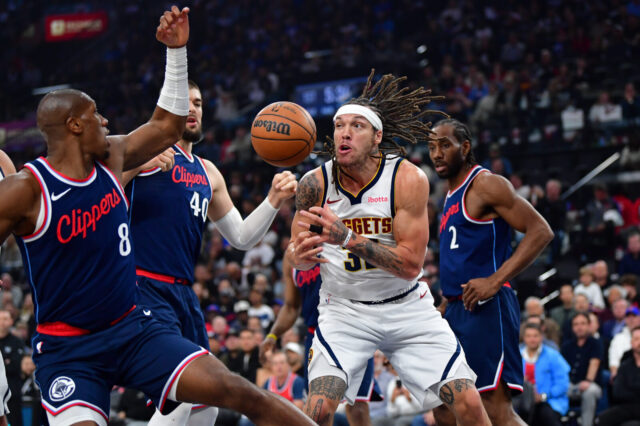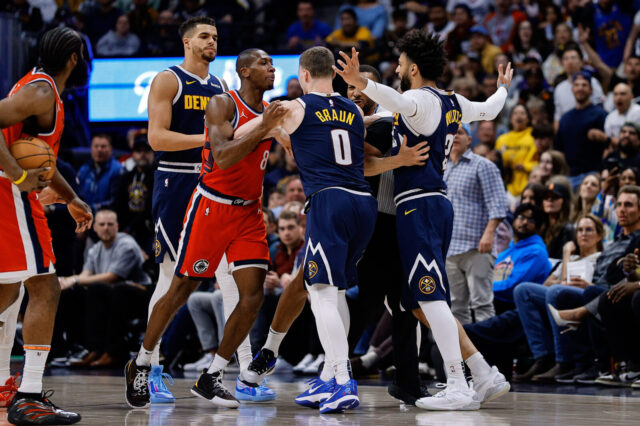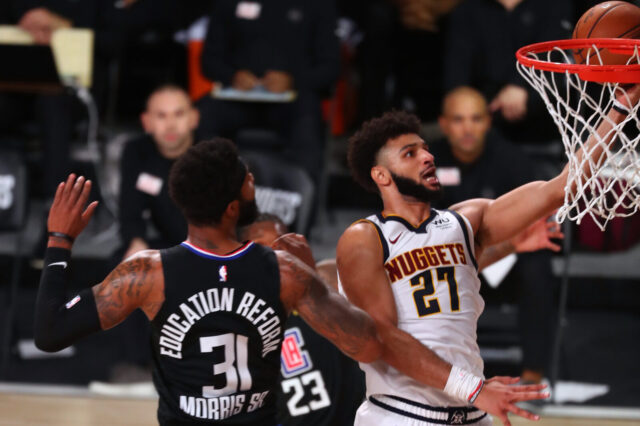The Denver Nuggets have made a “big change” to their pick and roll defense, according to head coach Michael Malone. The changes were immediately evident in their first televised game, even leading one blowhard to shout into the ether that is basketball twitter, “what the heck is Denver doing?”
Before we get into the weeds of the scheme change, it’s important to first look at why the team is changing their scheme. Nuggets head coach Michael Malone had this to say about Denver’s defense last season and the biggest point of emphasis this season:
“Last year overall, (the Nuggets were) 27th in three-point defense allowed, 30th in slot 3-point percentage allowed. So we’re trying to play pick-and roll more two on two.”
“We’re trying to change up our pick and roll defense a little bit. Trying to guard it a bit more 2 on 2, not as much weak side help. Teams are so good coming off (the screen), baiting the help, and kicking weak side, and that’s where we got hurt a lot.”
For Malone, the Nuggets defensive woes last season began with their pick and roll coverage and the numbers were as bad as Malone made them sound. Denver was 24th in DRTG last season, 28th in opponent 3FG%, 27th in percentage of opponent three-pointers that were assisted, and 27th in percentage of opponent three-point attempts that came from the corners. Ironically, the Nuggets also allowed the second most attempts at the rim, a sign that the team was being collapsed into the paint on defense, then stretched back out onto the perimeter, and collapsed again into the paint. In short, the Nuggets were being pushed and pulled inside out trying to contain dribble penetration, and it wasn’t working.
Knowing what the team’s issues were allowed Malone to restructure the team’s defensive scheme. “Big change,” as he put it. That change can be broken into two basic concepts: having the defender that is guarding the screener “zone up,” and having the weak side help “stay home.”
The first part is fairly simple. There are two defenders directly involved in a pick and roll; the guy guarding the screener, and the guy guarding the ball handler. The man guarding the screener is typically a front court player since most teams use their forwards and centers to set ball screens for a guard. In the Nuggets’ case, this is usually Jusuf Nurkic or Nikola Jokic.
This season, the Nuggets are having their bigs “drop” and “zone up,” not venturing too far outside of the painted area. In the image below, you can see how Nurkic is hanging back at the free throw line rather than chase D’Angelo Russell out to the three point line. As the ball handler advances, Nurkic slowly backs up into the paint, effectively conceding an off-the-dribble pull up jumper.
This content is no longer available.
The second part of the adjustment is that the other three Nuggets players, the ones NOT involved in the PnR, stick closely with their man, not providing help in the paint. In the image above, notice how Will Barton and Wilson Chandler are in no position to help stop D’Angelo if he gets past Nurkic, nor are they in position to put a body on the roll guy, Timofey Mozgov. Even Nikola Jokic, who is guarding Julius Randle on the wing, stays home, not involving himself in the PnR defense.
The trick here is that Nurkic is tasked with containing the ball handler and discouraging him from coming in to the paint while also keeping the roll guy from gaining rebounding position. It’s a tough balance for a big to make against a crafty guard which is why it is extremely important that the man defending the ball handler fights through the screen quickly. In this case, that is Mudiay.
According to Malone, the main thought behind this scheme is that the Nuggets are wanting to dictate what kind of shots their opponents take. “We know the shots we want on offense and we know the shots we want to give up on defense.” The shots they are willing to give up are off-the-dribble pull-up two-pointers.
Last season, the league average eFG% on pull-up jump shots was just over 40%. The league average eFG% for catch and shoot shots, was just under 52%. That’s a HUGE difference, and this season, the Nuggets are wanting to allow more of the former and less of the latter.
In practice, the new scheme is yielding some mixed results, at least this early in the preseason. The Nuggets have cut down on kickout three pointers out of pick and roll and have been in position to win every game this preseason. All of the Nuggets starting unit players have a positive plus/minus so far this preseason. But in the games against the Lakers, the Nuggets allowed D’Angelo Russell to go off for a total of 53 points.
“In Toronto, L.A., and Minnesota we did a very good job and the numbers bare it our. Give D’Angelo credit in that third game in Ontario, he hurt us from the mid-range. But it’s kind of a situation where, D’Angelo is getting off, we had the lead with five minutes to go in the game, no one else is getting off, and he’s beating us with the shot we want to give up.”
“Sometimes you have to tip your hat and give them credit, cause D’Angelo hit the shot that we’re willing to give up over an 82-game season. And obviously during a regular season game we’ll be quicker to adjust than we were in that game cause, they were I think, 11 of 21 from mid-range two’s that game which is excellent. So obviously we’ll have to adjust if we’re getting hurt like that.
What Malone is saying is that the strategy is designed to be vulnerable to mid-range shots, and that is okay. On some nights, a team might get hot from that zone but for the most part, the expected point value of those shots is worth allowing if it means the team can cut out all of the kickouts. And the Nuggets have cut the kickout opportunities. Speaking about the game in Ontario, Malone noted, “Out of the 14 made threes (by the Lakers), not one of them was from weak side, kick (outs).”
The new strategy will be something to keep an eye on all year long. The verdict on this scheme change won’t arrive after a few preseason successes or failures, the Nuggets defensive adjustments will be judged by how effectively they defend throughout the course of a year.
For now, it’s just interesting (and I’d argue it’s encouraging) to see that Malone is willing to make such a sweeping change to his defensive philosophies.


